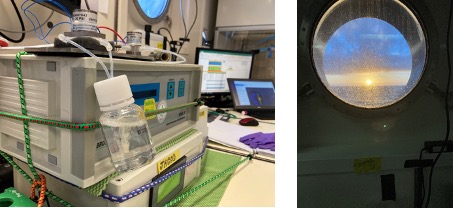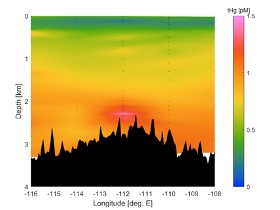Guten Tag from the fabulous mercury duo! We are Alina (PhD Student, University of Pau) on board for the Marine Mercury Lab at the Mediterranean Institute of Oceanography Marseille and Kati (Postdoc, GEOMAR). Our mission on this cruise is to provide new observations on all chemical forms of mercury (called Hg species) in the South Pacific and help to demystify the biogeochemical cycle of Hg in the Oceans. We are quickly approaching the end and we are happy to introduce you to our work!
Mercury is an element that is found in the environment with a complex biogeochemical cycle which includes also the active exchange between compartments (e.g. between atmosphere and ocean). The unique properties of Hg (eg. liquid at room temperature) have led to a widespread use in industrial applications or user products (eg. for thermometers in former times). Natural emissions e.g. from volcanic activity or hydrothermal vents are largely outcompeted by anthropogenic and legacy emissions. Hg keeps cycling through the environment and stays on Earth’s surface for a long time. The only sink where Hg is removed is via the burial of particles in deep ocean sediments.

Hg is present in different forms in the environment of which one is of particular concern for humans – methylated Hg (MeHg) – an organic Hg complex that can cause neurological damage if consumed in high quantities. MeHg accumulates in fish and seafood and is found in high concentrations in organisms that are high up in the trophic food chain (e.g. Tuna). Fortunately, the use of Hg has been reduced and an International treaty was ratified by 127 countries (Minamata convention) to decrease Hg emissions but legacy Hg keeps cycling in the environment. Despite many years of research, we still don’t fully understand the main drivers of MeHg formation in seawater. Additionally, as for many elements, the southern hemisphere is understudied and we are providing new information to the scientific Hg community.

We collected MeHg (water samples) and particulate Hg samples (filter material) along the transect to be measured back in the Laboratory in Marseille. We have also been carrying out on-board measurements with a customized setup using cold vapor generation atomic fluorescence spectrophotometry. We can determine two different forms of Hg with a small change of the introduction method into our instrument on-board. The total Hg content (THg) and dissolved gaseous mercury (DGM). DGM has to be measured as soon as possible after sampling and cannot be preserved for later measurements.
Therefore, we are lucky to leave the ship with about half of our measurement completed. This gives us the opportunity to share some exciting preliminary data with you all! When crossing the east pacific rise (EPR), a spreading zone where new oceanic crust is formed from rising magma, we encountered the plume of a hydrothermal vent system. Hydrothermal vents are a source of metals to oceanic waters and little is known of their role as a source of Hg to deep waters. We found a change in total Hg concentrations at the plume compared to surrounding deep waters. Little is known about input of Hg through hydrothermal vents and implications of these new findings are yet to be discovered.
We hope you enjoyed this little insight into our work on RV Sonne!
Many greetings from the South Pacific,
Alina Kleindienst (University of Pau) and Kati Gosnell (GEOMAR)